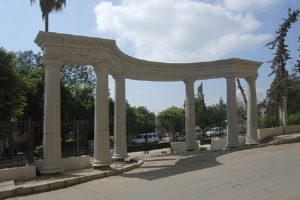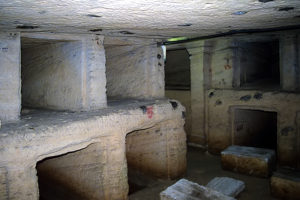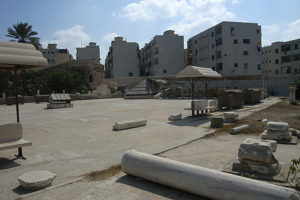The tombs of Kom el Shoqafa (meaning “Monds Shards”); an archaeological historical site located in Alexandria, in the Kom El Shoqafa area, south of Mina Al Basal neighborhood. The tomb consists of a series of tombs, statues, and Alexandrian relics to worship the Pharaonic funerals, and because of the time period then, many features of catacombs in Kom el Shoqafa collect Roman, Greek and Egyptian cultural points.
Some of the statues were made in Egyptian styles, but bear Roman styles in clothing and hair style, while other features shared a similar style. There is a circular stairway in the middle of it, leading to the tombs that were dug inside the rock during the era of the Antonine Emperors (second century AD), and it was used mostly to transport the dead bodies. The importance of the cemetery is due to its large number of decorations and the complexity of its layout, as it is considered one of the clearest examples of the intertwining of Pharaonic art with Roman art in the city and the finest examples of funerary architecture. The area was named by this name because of the abundance of pottery remains and breakers that visitors left during their visit, excavation began in this area Since 1892, the cemetery was only found by chance on September 28, 1900.
Most of the Roman era tombs in Alexandria are in the western necropolis, with the exception of the cemetery “Tigran Pasha Street” which was found in the east of the city
The cemetery (Kom el Shoqafa) is located south of (Mina Al Basal neighborhood) and is one of the most important cemeteries in the city of Alexandria and the region is called (Kom el Shoqafa) because of the abundance of pottery and crushers that accumulated in this place. Examples of mixing Pharaonic art with Roman art in Alexandria and the finest examples of funeral architecture in Alexandria
It appears that this cemetery was belonging to a wealthy family and was then used to bury many families after a group of welders took over. This group added some rooms and dug burial holes in the walls in one or two rows above each other, and the cemetery with four floors had A floor above the ground has ceased to exist over time, and the fourth floor is now submerged in water as a result of leakage of leaky water into the pores of the rock.
The planning can be summarized as follows:
Entrance to the surface of the ground, then a spiral staircase leading to the (first ground floor), which in turn consists of a vestibule that connects to a round hall in the middle of which is a well (ROTUNA) and adjacent to this round hall (rectangular hall) expanded shape equipped with three sofas is the banquet hall. At the end of the round hall there is a staircase leading to (the second ground floor), which is the floor where the main part of the burial is located in the cemetery, which is a room with three openings in the wall and two halls extending wrapping at right angles around the burial chamber and we find in these two halls holes and small rooms for burial Then we reach the (third ground floor) and it is now flooded. It was used for burial in a later era and was within the original planning of the cemetery. It is believed that this floor contained corridors leading to the (Serapeum), but this is not certain.
Spiral staircase
The spiral staircase revolves around a cylindrical well or a light hometown carved into the rock (about 6 meters in diameter) and its current depth reaches 10 meters and the ladder is built of square stone blocks in which round windows were formed from the top. About 1.20 meters, and in the form of a basement built of five rows of long adjacent stone blocks and notes that the lower steps of the stairs are more elevated than the upper (where the height of the steps gradually decreases until they are almost non-existent near the surface of the earth) and the secret to that as we know it in many of Roman buildings is that upward after visiting the deceased Eko N is more active and capable at the bottom than when approaching the surface of the earth, as fatigue has been taken from it, and therefore the higher steps seem as if the ascender does not climb a ladder but rather goes on a spiral path with a slight slope (to achieve the comfort of the visitor). As for the ladder lighting, it came through the holes that worked In Al-Munawar, by means of small rectangular holes in the wall on the sides of the ladder where pottery-lit oil lamps were used to light the rest of the tombs and also to burn incense, especially on important occasions





